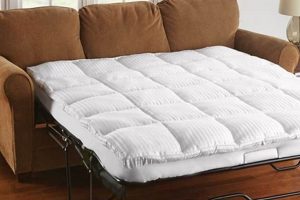A standard sleeping platform dimension found in recreational vehicles, typically measuring around 54 inches wide and 75 inches long, provides a dedicated space for rest within the confines of a camper. This area often necessitates a specialized cushioning solution tailored to fit the available space and provide adequate support for one or two occupants.
The presence of a correctly sized and supportive in-vehicle sleeping surface is vital for ensuring restful sleep, contributing directly to the overall enjoyment and safety of travel. Adequate sleep improves alertness, reduces fatigue-related risks, and enhances the vacation experience. Historically, improvised or inadequate bedding solutions were common; however, advancements in materials and manufacturing have led to specifically designed options that prioritize comfort and durability.
This article will delve into the various material options available for this essential component of camper outfitting, explore factors to consider when selecting the ideal one for individual needs, and examine maintenance practices to extend its lifespan. Considerations such as thickness, density, and breathability will be addressed, along with guidance on comparing different types.
Essential Considerations for Selecting a Sleeping Platform for Recreational Vehicles
Choosing the appropriate in-vehicle sleeping surface requires careful consideration of several factors to ensure optimal comfort and durability during travel. Prioritize materials and construction methods that align with intended usage and environmental conditions.
Tip 1: Assess Dimensions Accurately: Prior to purchase, precisely measure the available space within the camper. Ensure that the selected unit fits without requiring modification or causing obstructions.
Tip 2: Evaluate Material Density: Higher density foam, such as memory foam or latex, typically offers superior support and longevity compared to lower-density alternatives. Consider the weight capacity and expected frequency of use when making this determination.
Tip 3: Consider Breathability: Select materials that promote airflow to minimize moisture buildup and regulate temperature. Options with ventilation channels or open-cell structures can enhance breathability.
Tip 4: Research Cover Options: The cover material should be durable, water-resistant, and easily cleanable. Look for fabrics that are resistant to mildew and UV damage to withstand the rigors of outdoor use.
Tip 5: Examine Edge Support: Reinforcements along the perimeter can enhance stability and prevent sagging, particularly for those who tend to sleep near the edge.
Tip 6: Factor in Transportation and Storage: If storage space is limited, consider a foldable or rollable option to facilitate transport and maximize interior space when the platform is not in use.
Tip 7: Review Warranty Information: Thoroughly examine the warranty terms and conditions offered by the manufacturer. A comprehensive warranty can provide assurance against manufacturing defects and premature wear.
Selecting the correct size and appropriate material for the sleeping area in recreational vehicles ensures long-term comfort, durability, and a more enjoyable travel experience. By carefully considering these factors, individuals can make informed decisions that enhance the functionality and livability of their camper.
The subsequent sections will provide further information regarding the maintenance and care of this essential camper component, including cleaning procedures and storage recommendations.
1. Dimensions
The dimensions of a recreational vehicle sleeping platform directly dictate its suitability for a given camper model. A mismatch in size, even by a few inches, can render the unit unusable, necessitating modifications or a complete replacement. For instance, a sleeping platform designed for a slightly larger vehicle may not fit properly within a smaller camper, creating discomfort, safety hazards, and inefficient use of interior space. The selection process should begin with a precise measurement of the designated sleeping area to ensure compatibility.
Furthermore, dimension considerations extend beyond simple length and width. Thickness plays a role in comfort and headroom. A thicker option may provide greater cushioning but reduce vertical clearance, potentially impacting mobility within the camper. The location and accessibility of wheel wells or other interior obstructions should also be factored into the measurement process. Failure to account for these details can result in purchasing a unit that is incompatible with the vehicle’s interior configuration.
In summary, the relationship between dimensions and a recreational vehicle sleeping platform is critical for proper fit and functionality. Accurate measurements, combined with an understanding of interior space limitations, are essential for selecting a unit that maximizes comfort, safety, and efficient use of the available area. Disregard for dimension considerations can lead to dissatisfaction and the need for costly corrections.
2. Material Density
Material density within a sleeping platform for recreational vehicles exerts a significant influence on its support characteristics, durability, and overall comfort. Understanding this attribute is crucial for selecting an appropriate option that aligns with individual needs and usage patterns.
- Support and Pressure Distribution
Higher density materials, such as high-density memory foam or latex, offer superior support and distribute weight more evenly across the surface. This property minimizes pressure points, reduces discomfort, and promotes proper spinal alignment during rest. Conversely, lower density materials tend to compress more readily, leading to inadequate support and potential aches or pains.
- Durability and Longevity
The density of the material directly correlates with its resistance to deformation and degradation over time. Higher density materials are less susceptible to compression and sagging, maintaining their shape and support characteristics for a longer duration. This translates to enhanced longevity and reduced need for frequent replacements. Lower density options, on the other hand, may exhibit premature wear and require more frequent upkeep.
- Weight and Portability
Material density impacts the overall weight of the sleeping platform. Higher density options are generally heavier, which can affect portability and ease of handling, particularly in compact campers where weight limitations are a concern. Consideration should be given to the trade-off between support, durability, and weight when selecting the appropriate density.
- Temperature Regulation
Density can indirectly influence temperature regulation. Denser materials may restrict airflow and trap heat, potentially leading to discomfort in warmer climates. Conversely, some high-density materials are designed with open-cell structures or ventilation channels to improve breathability and minimize heat retention. Careful attention to material composition and construction is necessary to ensure comfortable sleeping temperatures.
The interrelationship between material density and these factors underscores its importance in the selection of a suitable camper sleeping surface. A thorough evaluation of these considerations, aligning with individual preferences and environmental conditions, ensures optimal comfort, support, and longevity of the unit. Selecting a unit without proper consideration leads to discomfort, reduces the sleep quality, and compromises structural integrity.
3. Breathability
The breathability of a camper’s sleeping surface is integrally linked to user comfort and hygiene, particularly within the confined space of a recreational vehicle. Limited airflow within the enclosed cabin environment necessitates bedding materials that facilitate moisture evaporation and temperature regulation. The presence of a non-breathable mattress can create a microclimate of elevated humidity, fostering the growth of mold and mildew and resulting in unpleasant odors. This effect is exacerbated during warmer months or in humid climates, where perspiration is more pronounced. Conversely, a mattress constructed with breathable materials promotes air circulation, dissipating moisture and maintaining a more temperate sleeping environment.
Examples of breathable materials commonly employed in camper sleeping platforms include open-cell foam, natural latex, and fabrics with moisture-wicking properties. Open-cell foam, unlike its closed-cell counterpart, allows air to permeate the structure, preventing moisture buildup. Natural latex, derived from rubber trees, inherently possesses breathable characteristics. Fabrics such as bamboo or specialized synthetics wick moisture away from the body, contributing to a drier and more comfortable sleep. Choosing a mattress with these attributes mitigates the risks associated with moisture accumulation and promotes a healthier sleeping environment.
Therefore, breathability stands as a critical consideration when selecting a recreational vehicle sleeping surface. Neglecting this factor can lead to compromised comfort, hygiene issues, and potential damage to the mattress and camper interior. Addressing concerns around breathability ensures improved sleep quality and enhanced camper longevity.It also supports a more hygienic environment by reducing humidity.
4. Cover durability
The durability of a recreational vehicle sleeping platform cover directly impacts the longevity and hygiene of the underlying mattress. As the outermost layer, the cover serves as the primary defense against environmental factors and physical wear, and its integrity is crucial for maintaining the integrity of the inner materials. The demands placed on a camper mattress cover differ significantly from those of a residential mattress due to the variable conditions encountered during travel.
- Protection Against Abrasions and Tears
Recreational vehicle sleeping platforms are frequently subjected to movement during transit, potentially leading to friction against interior surfaces or stored items. A robust cover, constructed from abrasion-resistant materials, minimizes the risk of tears or punctures. Durable fabrics such as reinforced nylon or tightly woven polyester offer enhanced protection against physical damage, preserving the integrity of the mattress core.
- Resistance to Moisture and Stains
Campers are exposed to a range of environmental conditions, including humidity, spills, and condensation. A water-resistant or waterproof cover prevents moisture from penetrating the mattress, inhibiting the growth of mold, mildew, and bacteria. Stain-resistant treatments further enhance the cover’s ability to repel liquids and maintain a clean appearance. These properties are particularly important in minimizing odors and prolonging the lifespan of the mattress.
- UV Resistance and Colorfastness
Prolonged exposure to sunlight can degrade many fabrics, causing them to fade, crack, or become brittle. A cover with inherent UV resistance or a UV-protective coating mitigates these effects, preserving its color and structural integrity over time. This is especially relevant for recreational vehicles that are frequently parked in direct sunlight, as the cover is consistently exposed to solar radiation.
- Ease of Cleaning and Maintenance
Practicality dictates that a camper mattress cover should be easily cleaned and maintained. Removable and machine-washable covers facilitate regular cleaning, allowing for the removal of dirt, allergens, and odors. Materials that are resistant to shrinking, stretching, or pilling after washing contribute to the long-term maintainability of the unit. Simple care routines help extend the life of the cover and preserve a hygienic sleeping environment.
The facets of cover durability collectively determine the overall resilience and lifespan of a camper mattress. Selection of a high-quality cover, designed to withstand the rigors of travel and environmental exposure, represents a crucial investment in the long-term comfort, hygiene, and value of the recreational vehicle sleeping arrangement. Without a proper cover, the benefits of a full size camper mattress can be quickly negated by damage or degradation.
5. Edge Support
Edge support, a critical component in the design of a recreational vehicle sleeping surface, refers to the reinforcement and structural integrity along the perimeter. Its presence directly affects the usable sleep surface, stability, and overall comfort, especially for those occupying the edges of the platform. Insufficient edge support in a “full size camper mattress” results in a sloping or collapsing edge when weight is applied, reducing the effective sleeping area and potentially leading to discomfort or even falls. Real-world examples of this deficiency include scenarios where individuals roll off the edge during sleep or experience a feeling of instability when sitting on the side of the platform. This understanding is practically significant because it highlights the need for careful consideration of edge support features during the selection process.
Furthermore, the quality of edge support also impacts the long-term durability of the sleeping surface. Without adequate reinforcement, the edges are more susceptible to wear and tear, leading to sagging and premature degradation of the entire structure. The impact is noticeable in long-term use where a mattress with inadequate edge support deforms around the perimeter, rendering some parts unusable. Camper owners should look for features like reinforced coils, high-density foam encasements, or specialized edge support systems when evaluating options. These enhance structural integrity, prevent sagging, and extend the lifespan of the “full size camper mattress”.
In summary, effective edge support is a paramount consideration when selecting a “full size camper mattress”. It directly influences the usability, comfort, and longevity of the sleeping surface. Neglecting this aspect can compromise the overall sleep experience and necessitate premature replacement. Addressing edge support deficiencies is essential for optimizing the functionality and value of the sleeping area within a recreational vehicle and for ensuring a more restful and secure sleeping environment.
6. Portability
The concept of portability assumes considerable importance when evaluating sleeping solutions for recreational vehicles. A “full size camper mattress”, while offering a standard sleeping area, presents unique challenges related to transport, storage, and handling within the typically confined spaces of a camper.
- Weight Considerations
The weight of a “full size camper mattress” directly affects the overall payload capacity of the recreational vehicle. Excessive weight can compromise fuel efficiency, handling, and potentially exceed the vehicle’s weight limits, creating safety hazards. Material selection significantly influences the weight of the mattress, with options such as memory foam, latex, or hybrid constructions offering varying degrees of weight and support. Campers must carefully balance comfort requirements with weight limitations.
- Compression and Storage
The ability to compress or fold a “full size camper mattress” greatly enhances its portability and storage convenience. Traditional innerspring mattresses lack this compressibility, occupying significant space even when not in use. Alternatives like foldable foam mattresses or air mattresses offer greater flexibility for storage, allowing for more efficient utilization of limited camper space. The ease of compression is a crucial factor for travelers who prioritize minimizing clutter and maximizing living area.
- Handling and Maneuverability
The dimensions and weight of a “full size camper mattress” impact its ease of handling during setup and takedown. Transporting a bulky and heavy mattress through narrow camper doorways and corridors can be physically demanding. Mattresses with integrated handles or lightweight designs facilitate easier maneuverability, reducing the effort required for deployment and storage. Attention to handling characteristics can significantly improve the convenience of using a “full size camper mattress”.
- Durability During Transport
Frequent transport and handling can expose a “full size camper mattress” to potential damage. A durable cover and robust construction are essential to withstand the rigors of travel. Mattresses designed with reinforced edges and tear-resistant materials are better equipped to resist damage from impacts, abrasions, and compression. Investing in a durable mattress reduces the risk of premature wear and ensures a longer lifespan.
These facets of portability highlight the inherent trade-offs between comfort, convenience, and durability when selecting a “full size camper mattress” . Owners of recreational vehicles must weigh these factors carefully to arrive at a solution that meets their specific needs and travel habits, ensuring that the sleeping platform is both comfortable and manageable within the context of the camper environment.
Frequently Asked Questions Regarding Full Size Camper Mattress
The following section addresses common inquiries pertaining to the selection, maintenance, and performance of a full size camper mattress in recreational vehicles.
Question 1: What constitutes the standard dimensions for a full size camper mattress?
The standard dimensions typically measure approximately 54 inches in width and 75 inches in length. Variations may exist depending on the specific camper model and manufacturer. Precise measurements are advised before purchase.
Question 2: What materials are commonly used in the construction of these mattresses?
Common materials include memory foam, latex, polyurethane foam, and innerspring coils. Hybrid constructions combining multiple materials are also prevalent. The choice of material influences comfort, support, and durability.
Question 3: How should a camper mattress be properly cleaned and maintained?
Regular vacuuming removes surface debris. Spot cleaning addresses stains using mild detergent and water. Allowing the mattress to air dry thoroughly prevents moisture buildup and mildew growth. Use of a mattress protector is advisable.
Question 4: What factors influence the longevity of a camper mattress?
Factors influencing longevity include material quality, frequency of use, weight of occupants, and environmental conditions. Proper cleaning and maintenance contribute significantly to extending the lifespan.
Question 5: Is it possible to customize a camper mattress to specific dimensions?
Customization options are available through certain manufacturers. Tailoring the mattress to precise dimensions ensures optimal fit within the camper. Additional costs may apply.
Question 6: What are the implications of mattress density on sleep quality?
Higher density materials generally provide greater support and pressure relief, contributing to improved sleep quality. However, personal preferences and individual sleeping habits influence the optimal density level.
In summary, understanding the dimensions, materials, maintenance, and other variables associated with a full size camper mattress is essential for ensuring a comfortable and durable sleeping solution within a recreational vehicle.
The subsequent section will delve into specific considerations for selecting a camper mattress based on different travel styles and environments.
Concluding Remarks on Full Size Camper Mattress Selection
This exploration has underscored the multifaceted considerations inherent in selecting a full size camper mattress. Dimensions, material density, breathability, cover durability, edge support, and portability each exert a distinct influence on the sleeping experience within a recreational vehicle. A balanced assessment of these factors, aligned with individual needs and environmental conditions, is paramount for optimizing comfort and longevity.
The informed selection of a full size camper mattress constitutes a critical investment in the overall quality of travel. Neglecting these key considerations can lead to compromised sleep, reduced comfort, and premature degradation of the unit. Therefore, a comprehensive understanding of these aspects empowers individuals to make judicious decisions that enhance the livability and value of their recreational vehicle.


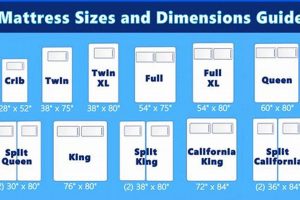
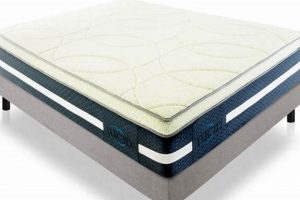
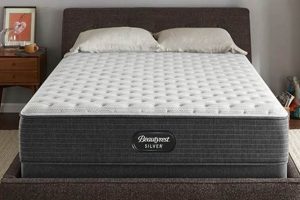
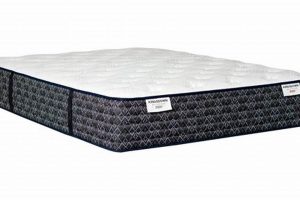
![Best Plush Full Size Mattress [Guide] For Comfort Sleep Organic & Natural Mattress Buyer’s Guide: Non-Toxic Sleep Solutions Best Plush Full Size Mattress [Guide] For Comfort Sleep | Organic & Natural Mattress Buyer’s Guide: Non-Toxic Sleep Solutions](https://mattressworldpa.com/wp-content/uploads/2025/07/th-2793-300x200.jpg)
